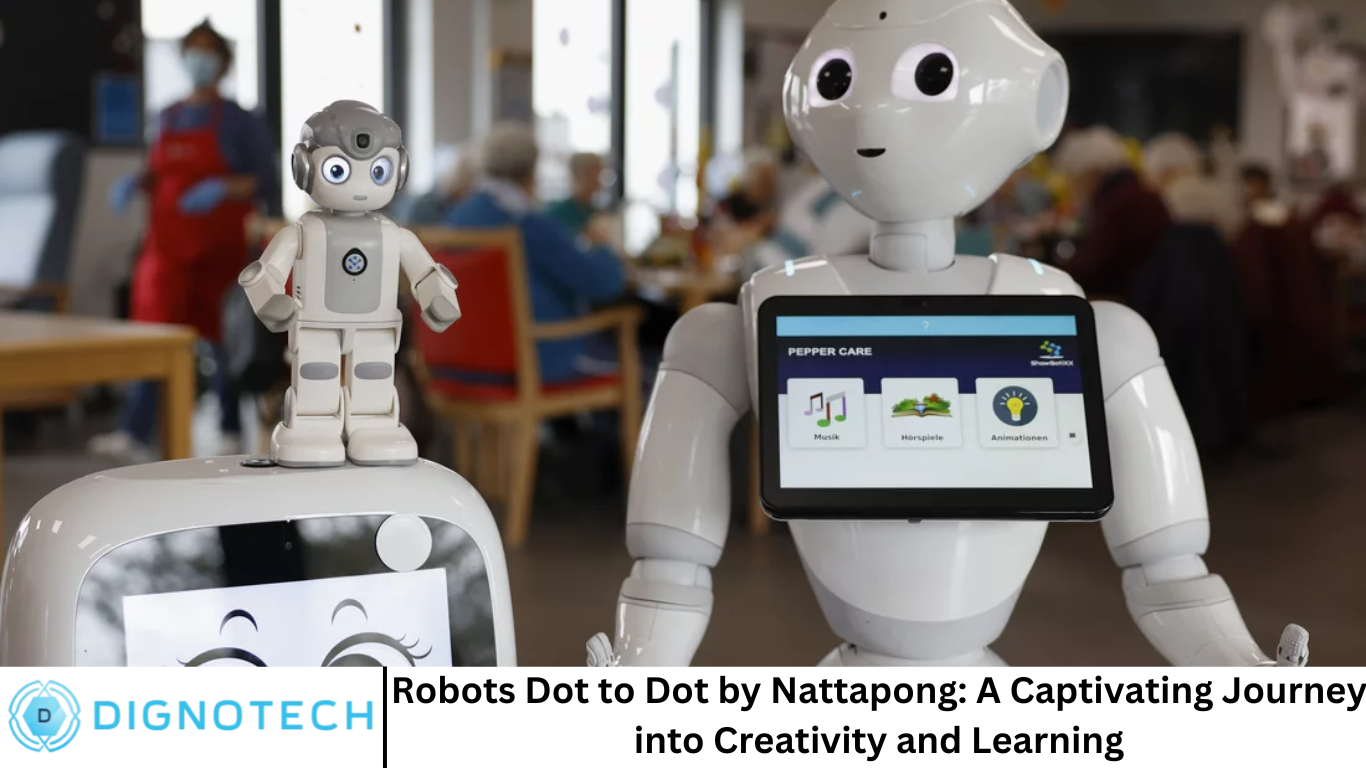Robots Dot to Dot by Nattapong: A Captivating Journey into Creativity and Learning

Hi everyone! How are you all doing? Welcome to dignotech.com! In today’s fast-paced digital world, where gadgets and screens dominate, it can often be challenging to engage children in activities that stimulate both their creativity and cognitive development. Robots Dot to Dot by Nattapong is a delightful and innovative book that not only entertains but also fosters valuable learning skills in young minds. This captivating journey, through the form of dot-to-dot puzzles featuring robots, combines the fun of puzzle-solving with the exploration of creativity and critical thinking.
Robots Dot to Dot is more than just a simple puzzle book. It is an interactive experience that encourages children to use their imagination while developing important skills such as problem-solving, hand-eye coordination, and attention to detail. The book is designed for children of various ages, ranging from young kids to older children who are ready for a more challenging activity. Through the innovative use of robots as the central theme, the book introduces the concept of mechanical designs and futuristic technology, making learning both fun and educational.
Each page of Robots Dot to Dot features intricate illustrations of robots, waiting to be brought to life by connecting the dots in sequential order. The puzzles range from simple, smaller designs to complex, larger mechanical creations, allowing children to gradually improve their skills as they progress through the book.
The Power of Dot to Dot Puzzles
Dot to dot puzzles have been a popular activity for generations. They offer children a fun way to exercise their brains while developing a variety of cognitive skills. The act of connecting dots to form an image requires attention, concentration, and patience, all while working with shapes and patterns.
But why exactly is dot to dot so powerful in encouraging creativity and learning?
- Develops Fine Motor Skills: For younger children, the physical act of drawing lines from dot to dot enhances fine motor skills and hand-eye coordination. It’s a fun way for children to improve their ability to control writing instruments and make precise movements, a foundational skill needed for later writing and drawing.
- Boosts Cognitive Development: Dot to dot puzzles, especially those in Robots Dot to Dot, require children to think sequentially, which boosts their cognitive development. The need to follow a specific order of dots helps children develop their logical thinking, an essential skill for problem-solving and future learning.
- Enhances Focus and Patience: Completing a dot-to-dot puzzle is a task that requires sustained focus and concentration. For children, this is an excellent exercise in patience and persistence as they work toward completing the puzzle and revealing the final image.
- Stimulates Creativity: One of the most important benefits of dot-to-dot puzzles, especially those with a creative twist like Robots Dot to Dot, is the way they stimulate imagination. The robotic designs challenge children to think outside the box and envision how these mechanical creations could function in real life.
- Increases Spatial Awareness: Connecting dots in a specific order helps children develop spatial awareness by allowing them to visualize how parts of the puzzle fit together. This skill is important in many areas of learning, such as mathematics, geometry, and even reading comprehension.
- Improves Problem-Solving Skills: Each puzzle presents a challenge, which requires children to think critically and solve problems. As they work through the puzzles, they learn how to approach problems step by step, refining their problem-solving techniques as they go.
- Boosts Confidence: There’s a sense of accomplishment and confidence that comes with completing a puzzle. When a child finishes a dot-to-dot puzzle and sees the finished robot drawing, they feel a sense of pride and achievement, motivating them to tackle more complex challenges.
A Closer Look at the Theme of Robotics
One of the most engaging aspects of Robots Dot to Dot is the theme of robotics and futuristic technology. In today’s world, robotics plays an increasingly important role, from manufacturing and engineering to healthcare and artificial intelligence. This book not only introduces children to the concept of robots but also sparks curiosity about technology and innovation.
Through the illustrations of robots, children are given a glimpse into the world of machines and how they function. The intricate robot designs in the dot-to-dot puzzles reflect the diverse and ever-evolving field of robotics. These puzzles challenge children to think about how robots might be constructed, what roles they could play in society, and how technology can improve our lives.
This thematic approach helps to foster a greater appreciation for STEM (Science, Technology, Engineering, and Mathematics) subjects. It encourages children to ask questions about the world around them and consider future careers in fields such as robotics, engineering, or technology. The themes of innovation and problem-solving tie directly into the broader curriculum and help children understand the importance of creativity and knowledge in shaping the future.
The Role of Art in Education
Robots Dot to Dot is an excellent example of how art can be integrated into educational activities. The process of completing dot-to-dot puzzles is not only about forming an image but also about developing creativity and visual thinking. Children are given the opportunity to see how small details come together to create something larger and more meaningful, fostering an appreciation for both art and structure.
Art plays a crucial role in a child’s education by encouraging creativity, expression, and problem-solving. By engaging in activities like dot-to-dot puzzles, children learn to observe the world around them, make connections between concepts, and create something of their own. These skills are important not just for artists but for future scientists, engineers, and thinkers who need to think creatively in their fields.
How Robots Dot to Dot Benefits Different Age Groups
Robots Dot to Dot is versatile in that it can be adapted to children of various age groups, each gaining something unique from the activity.
- For Younger Children (Ages 4-6): The simpler puzzles with larger dots help younger children develop their fine motor skills and ability to focus. These activities engage their sense of play and exploration while introducing basic concepts of shapes and patterns. The robots, though simple, are still fascinating and serve as a perfect introduction to the world of futuristic technology.
- For Older Children (Ages 7-10): As children grow older, they can tackle more complex puzzles. These challenges require a higher level of concentration and problem-solving ability. At this stage, children can start to think about the design and function of robots in greater detail. Robots Dot to Dot also provides an excellent opportunity to introduce discussions about engineering, programming, and robotics as career possibilities.
- For Tweens and Teens (Ages 11+): With intricate puzzles and more detailed designs, older children can tackle the most advanced puzzles in the book. This is an opportunity for them to work on precision, focus, and fine details. The futuristic robot illustrations can spark conversations about robotics in modern life, artificial intelligence, and technological advancement.
Frequently Asked Question
What is Robots Dot to Dot by Nattapong?
Robots Dot to Dot is an interactive puzzle book that features dot-to-dot illustrations of robots. The puzzles are designed to engage children in a creative and educational activity, helping them develop important cognitive and motor skills while fostering a love for technology and robotics.
What age group is Robots Dot to Dot suitable for?
The book is suitable for children of various age groups. Younger children (ages 4-6) can enjoy simpler puzzles, while older children (ages 7-10) can tackle more complex designs. Even tweens and teens can engage with the advanced puzzles for a more challenging experience.
How does Robots Dot to Dot help with learning?
The book helps children develop fine motor skills, attention to detail, logical thinking, problem-solving abilities, and creativity. By connecting dots in a specific sequence, children enhance their cognitive development and gain a greater understanding of how shapes and patterns work together.
What makes Robots Dot to Dot different from other puzzle books?
Robots Dot to Dot stands out because it combines the fun of dot-to-dot puzzles with the theme of robotics. The robot illustrations spark creativity and curiosity about technology and innovation, making it an excellent tool for introducing children to STEM concepts in an engaging way.
Can adults enjoy Robots Dot to Dot too?
While Robots Dot to Dot is primarily designed for children, adults who enjoy puzzles or are interested in robotics may also find it fun and challenging. The intricate designs can appeal to people of all ages, offering a relaxing and creative activity.
Does the book contain instructions for beginners?
Yes, the book starts with simpler puzzles, making it accessible to younger children or beginners. As the puzzles become more challenging, the instructions help guide children in improving their skills while providing a sense of accomplishment as they progress.
Can Robots Dot to Dot be used as an educational tool in schools?
Absolutely! Robots Dot to Dot is a fantastic tool for use in educational settings. Teachers can incorporate it into lessons about robotics, technology, art, and problem-solving. It encourages creativity, fosters critical thinking, and provides a hands-on way for students to learn about design and innovation.
Conclusion
Robots Dot to Dot by Nattapong is a wonderful book that brings together creativity, learning, and technology in a way that is both fun and educational. It helps children develop important skills such as problem-solving, motor coordination, and creativity while introducing them to the exciting world of robotics and innovation. Whether for individual use or as a tool in the classroom, this book offers an engaging and enriching experience for children of all ages.





